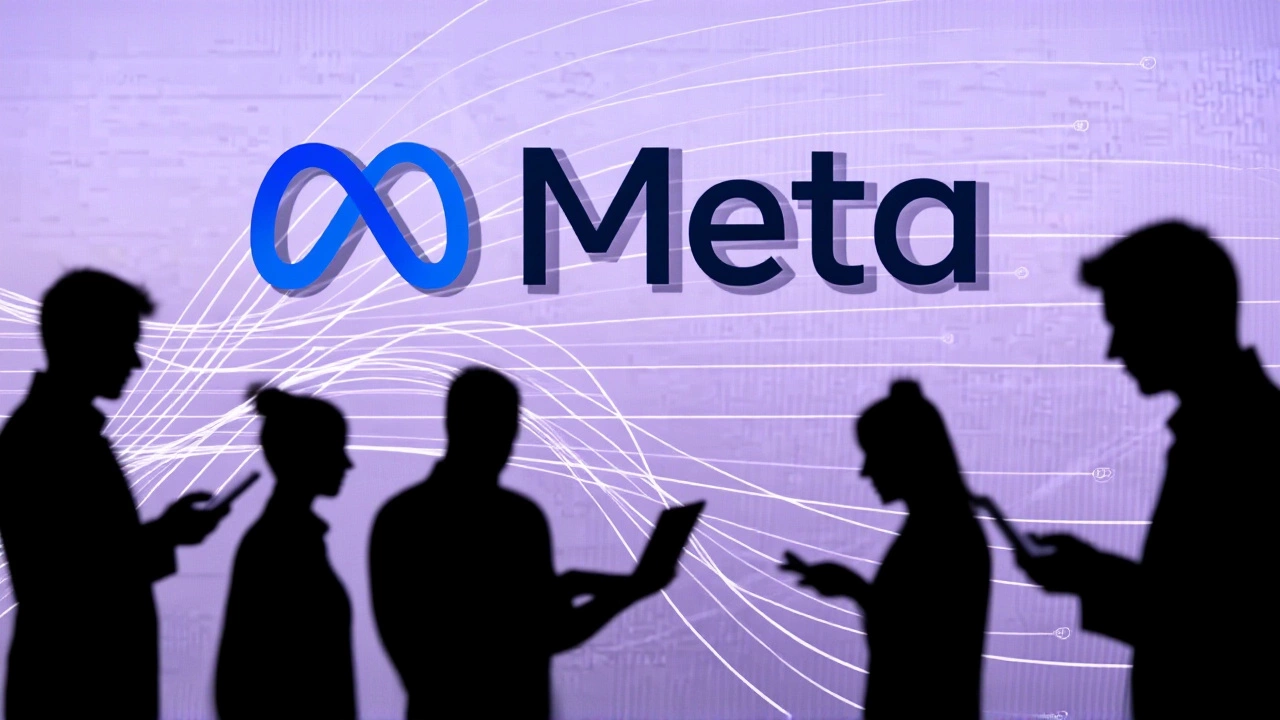When Meta Platforms released its third-quarter 2025 results after market close on Wednesday, October 29, 2025, investors expected a win. Revenue hit $51.2 billion — up 26.2% year-over-year — and non-GAAP earnings per share soared to $7.25, crushing the $6.74 consensus. But here’s the thing: the market didn’t care. Meta’s stock plunged over 9% in after-hours trading. Why? Because behind the glossy numbers was a $15.9 billion tax charge, a spending spree that left even Wall Street breathless, and quiet doubts about whether AI’s promise can be monetized fast enough.
Behind the Numbers: A Tax Shock and a Spending Spree
The GAAP net income of $2.7 billion — or $15.00 per share — looked impressive until you dug deeper. That figure included a one-time, non-recurring tax charge tied to the new U.S. corporate tax law. Without it, Meta’s actual profit was $18.6 billion, or $7.25 per share. That’s not just good — it’s exceptional. But investors aren’t just looking at profit. They’re looking at cash flow, and that’s where things got complicated.
Meta spent $19.4 billion on servers, data centers, and network infrastructure in just three months. That’s more than the entire annual IT budget of most Fortune 500 companies. Free cash flow still came in at $10.6 billion, but the sheer scale of spending sent a signal: this isn’t a company optimizing anymore. It’s betting everything on AI.
And the bets are wide. Executives revealed they began piloting a new runtime ad-ranking model in Q3 — one that uses more data and compute power than any prior system. "It would pay off... in 2026," they said. That’s not a promise. It’s a gamble. And the market is asking: why wait?
AI Is the Engine — But Is It the Revenue Driver?
Bank of America analysts were blunt: "We’re watching what Meta says about AI." And what they heard was promising but vague. Meta highlighted growth in daily active users across Facebook, Instagram, and WhatsApp. Time spent on both platforms accelerated. Advertisers are adopting Gen-AI tools to create creatives faster. But monetization? That’s the hang-up.
Compare that to Alphabet, which reported its own Q3 results the same day. Google’s ad revenue growth was expected at 13% — half of Meta’s 26.2%. Yet Alphabet’s stock didn’t tank. Why? Because Google’s AI tools are already baked into search, YouTube, and cloud services — revenue streams that are proven. Meta’s AI is still in the lab. The ad model is being rebuilt from the ground up. That’s risky.
"It’s like building a new highway while traffic is still flowing," said one anonymous hedge fund manager who spoke to Bloomberg. "You can’t shut it down. But if the new lanes aren’t ready by the time the trucks arrive, you’re stuck with a $20 billion parking lot."
Wall Street’s Contradictory Signals
Here’s the twist: Wall Street is both bullish and nervous. TD Cowen raised its target price to $875 — a 25% upside from where Meta traded post-earnings. Several firms issued "strong buy" ratings. Yet Bank of America stuck with its $900 target, even as the stock dropped. That’s not a downgrade. It’s a statement: they believe the pain today will be the gain tomorrow.
Meanwhile, Northeast Investment Management quietly increased its stake in Meta by 1.4% in Q2, making it the eighth-largest holding in its portfolio — worth $78.9 million. That’s not the kind of move a fund makes unless it’s betting on a multi-year turnaround.
Meta’s valuation metrics tell a similar story. The P/E ratio sits at 27.21 — high, but not absurd given its growth. The PEG ratio of 1.59 suggests the stock is fairly priced relative to earnings growth. And with a beta of 1.20, it’s more volatile than the market — which is exactly what growth investors want. But volatility scares the cautious.
What Comes Next? The 2026 Inflection Point
Meta’s executives didn’t just hint at bigger spending in 2026 — they promised it. "Capital expenditures will be notably larger," they said. That means more data centers. More AI chips. More engineers. More electricity bills. The company ended Q3 with $44.4 billion in cash and marketable securities — enough to fund this for years. But it’s not just about money. It’s about timing.
Analysts are forecasting $26.70 EPS for the full year 2025 — nearly double the Q3 non-GAAP rate. That implies a massive surge in the fourth quarter. Is that realistic? Maybe. But if Q4 disappoints, the stock could fall further. And if it delivers? We could see a rally that makes this 9% drop look like a buying opportunity.
One thing’s clear: Meta isn’t playing defense anymore. It’s going all-in on AI infrastructure, betting that its ability to target ads better than anyone else — using real-time, compute-heavy models — will make it the undisputed king of digital advertising by 2027. The question isn’t whether it can build the tech. It’s whether advertisers will pay for it soon enough to satisfy Wall Street’s appetite for quarterly wins.
Background: A Company in Transition
Meta’s journey since 2021 has been a rollercoaster. After the metaverse hype faded and ad revenue slowed, CEO Mark Zuckerberg pivoted hard to AI. The company laid off 11,000 employees in 2022, then doubled down on AI hiring. By 2024, it had built its own custom AI chips — the MTIA v2 — to reduce reliance on NVIDIA. Now, it’s using those chips to power ad ranking, content recommendation, and even customer service bots.
It’s also quietly integrating AI into its CRM tools. Advertisers can now generate ad copy, images, and video variations in seconds — all optimized for engagement. Early data suggests these AI-generated ads have 22% higher click-through rates than human-created ones. But scaling that to billions of daily users? That’s the real challenge.
And then there’s the competition. TikTok’s ad platform grew 48% last year. Amazon’s retail ads are now bigger than Google’s. Meta’s dominance isn’t guaranteed — just assumed. The market is now testing whether that assumption still holds.
Frequently Asked Questions
Why did Meta’s stock drop despite beating earnings estimates?
Despite non-GAAP EPS of $7.25 beating estimates of $6.74, investors reacted to a $15.9 billion one-time tax charge that slashed GAAP net income to $2.7 billion. More critically, the $19.4 billion in Q3 capital spending — mostly on AI infrastructure — raised concerns about near-term profitability. The market wants faster monetization of AI, not just heavy investment.
How does Meta’s AI advertising model differ from Google’s?
Meta’s AI focuses on real-time ad ranking using massive user data from Facebook, Instagram, and WhatsApp to personalize ads with unprecedented precision. Google’s AI enhances search intent and YouTube recommendations, leveraging its dominance in search and video. Meta’s model is more behavioral and social; Google’s is more contextual and intent-based. Both are powerful, but Meta’s is riskier — it’s still proving its ROI at scale.
What’s the significance of Meta’s $19.4 billion in Q3 capital expenditures?
That spending — nearly double what Amazon spent on infrastructure in Q3 — signals Meta’s commitment to becoming an AI-first company. The money went to custom AI chips, data centers, and network upgrades to handle the compute demands of next-gen ad targeting. It’s not just about growth; it’s about survival. Competitors like TikTok and Amazon are catching up, and Meta can’t afford to fall behind.
Is Meta’s 2026 spending forecast a red flag or a sign of confidence?
It’s both. The "notably larger" capex forecast suggests management expects AI initiatives to scale dramatically — which requires upfront investment. But it also means profits will be pressured for another year. For long-term investors, it’s a vote of confidence. For quarterly traders, it’s a warning. The market will judge them based on whether 2026 delivers measurable ad revenue gains from these investments.
How do analysts justify their $875–$900 price targets after the stock drop?
Analysts believe Meta’s AI-driven ad improvements will unlock $15–$20 billion in incremental revenue by 2027. With 3.2 billion monthly active users and a 40% operating margin, even small efficiency gains translate to massive profits. The current stock price reflects short-term pain; the targets reflect long-term potential. If AI monetization accelerates in 2026, the stock could easily double from its 2024 lows.
What’s the risk if Meta’s AI ad model fails to deliver in 2026?
If the new ad ranking models don’t significantly outperform legacy systems, advertisers may shift budgets to TikTok, Amazon, or Google — platforms with more proven AI tools. Meta could face declining ad CPMs, slower user engagement growth, and pressure to cut spending. That would trigger a vicious cycle: less revenue → less AI investment → weaker competitive edge. The stakes couldn’t be higher.





Write a comment